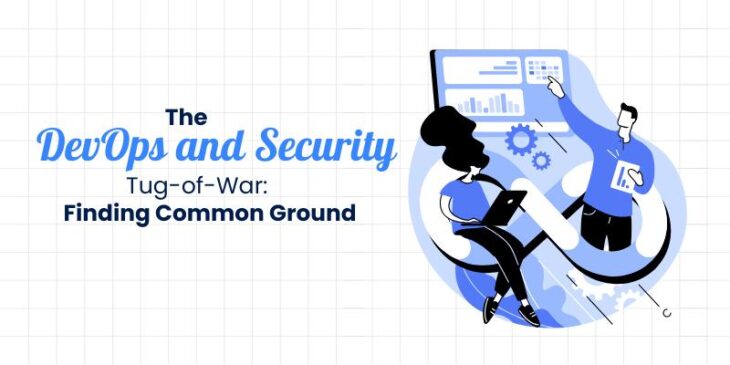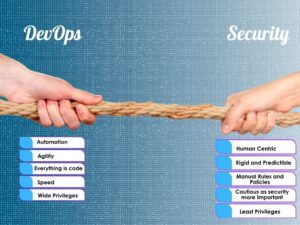
Imagine enterprise IT as a high-stakes competition, where DevOps is sprinting through a hundred-meter dash, while Security is carefully organizing a chess tournament—both competing in the same lane. The result? A predictable collision.
In the past, IT operations were more straightforward. Security played the role of a vigilant castle guard, ensuring systems were locked down and protected. Meanwhile, Development moved at a slow, measured pace, with quarterly releases and multiple sign-offs. It may have been sluggish, but it was manageable. However, with the advent of cloud computing, the pace of change exploded. What was once a structured, controlled environment has become a race to innovate, with multiple priorities, creating friction and potential chaos.
Conflicting Priorities: Where DevOps and Security Diverge
The core of the challenge lies in the differing goals of DevOps and Security:
-DevOps: “Make it work. Make it fast. Scale it now!”
– Security: “Make it safe. Make it controlled. Follow compliance.”
As DevOps is driven by the pressure to innovate, build, and deploy faster than ever, Security remains focused on mitigating risk and ensuring the integrity of systems. DevOps’ philosophy of “move fast and break things” can be exhilarating for development teams but represents a nightmare scenario for Security, which strives to avoid breaches and vulnerabilities that could cripple an organization.
The Disruption of Cloud Computing
There was a time when provisioning new infrastructure was a slow, meticulous process, involving layers of approvals, documentation, and security checks—Security’s ideal state of control. But with the rise of cloud computing, DevOps gained the ability to deploy entire infrastructures with the swipe of a credit card, transforming the landscape overnight.
For DevOps, this newfound autonomy was liberating. For Security, it was a loss of control, as systems multiplied rapidly, and vulnerabilities spread like wildfire. The orderly world of IT had become the Wild West, with Security scrambling to keep up.
The Battle Over Privileges: Who Holds the Keys?
One of the most contentious issues between DevOps and Security is the question of privilege management. DevOps teams, focused on speed and efficiency, often argue for broader access rights so they can troubleshoot and resolve issues without delay. Security, however, adheres to the principle of least privilege, knowing that excessive access can lead to catastrophic vulnerabilities.
This conflict often results in a standoff: DevOps demands full access to maintain agility, while Security fights to minimize permissions, wary of the potential risks. The outcome is frequently a compromise that leaves both sides unsatisfied.
Shadow IT: The Unintended Consequence of Restriction
When Security blocks access or services, DevOps doesn’t simply stop. Instead, they find workarounds, leading to the rise of Shadow IT. Entire infrastructures can be spun up without formal approval, often without Security’s knowledge. This introduces unmonitored systems, creating potential entry points for attackers. By the time Security discovers these shadow systems, it may already be too late to prevent a breach.
The Stakes: Risk of Breaches vs. Competitive Advantage
The stakes of this tug of war are profound. Move too quickly, and you risk a security breach that could result in financial loss and reputational damage. Move too slowly, and you lose your competitive edge, allowing rivals to outpace you in the market. The balance between speed and safety is crucial, as both extremes come with significant risks to the business.
DevSecOps: The Path to Harmonizing Speed and Security
The solution lies in collaboration, not in one side prevailing over the other. The emergence of DevSecOps offers a path forward, where security is no longer an afterthought but an integrated part of the development process. This model embraces a shared responsibility between DevOps and Security, allowing for agility without sacrificing safety.
The Evolution of Security:
Security teams must transition from being the “Department of No” to becoming enablers of secure innovation. By embedding security practices early in the development process, they can ensure that systems are both fast and secure, reducing the friction that traditionally exists between these two functions.
The Role of DevOps:
DevOps must recognize that speed without security is unsustainable. By incorporating security into continuous integration and continuous delivery (CI/CD) pipelines and automating compliance checks, DevOps teams can maintain their pace of innovation while ensuring that security is not compromised.
Automation: The Key to Reducing Friction
Automation is critical in bridging the gap between DevOps and Security. By automating security checks, policy enforcement, and compliance, both teams can work in harmony without slowing each other down. DevSecOps is the future, where security is built into the pipeline, ensuring both speed and safety.
Aligning for Success: A Unified Team
Ultimately, DevOps and Security are not adversaries; they are both essential players on the same team. The goal is not merely to deploy faster or lock systems down but to build secure, scalable, and resilient systems that drive business success. The challenge is finding a balance where both teams can move in tandem, rather than in opposition.
While this alignment may sometimes feel like a delicate dance—and occasionally resemble a mosh pit—the focus should remain on collaboration. By embracing a shared vision of secure innovation, organizations can ensure that they are pulling in the same direction, building a future where agility and security are not mutually exclusive but mutually reinforcing.
You might also like:
🚀 Webinar: Maximize ROI with DevSecOps
Uncover strategies to accelerate releases, enhance security, and reduce costs with an internal DevSecOps platform.
Master CI/CD, automation, and ROI measurement in this value-packed session tailored for tech leaders and DevOps pros!
⌛Date & Time: November 7th, 2024
ET: 11:00 AM – 01:00 PM
IST: 8:30 PM – 10:30 PM
Ready to transform your business infrastructure and enhance your user experience? Talk to Us!




